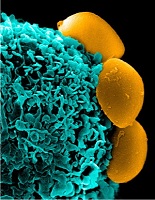 |
| Cloaked nanoparticle resembles white blood cell.--Courtesy of Methodist Hospital Research Institute |
Call it the Trojan horse of nanomedicine: Researchers have developed a way to cloak drug-carrying nanoparticles with the same membranes as the body's own white blood cells, allowing those drugs to bypass the immune system without being harmed.
Specific molecules on white blood cells' membranes signal to other cells that they belong in the body. By coating nanoparticle drug vehicles with these same lipids and proteins, scientists at the Methodist Hospital Research Institute in Houston have created "LeukoLike Vectors," or LLVs, that are similarly welcomed by the immune system.
The researchers developed a procedure to physically remove the membranes from active white blood cells and drape them over the nanoparticles. The part-synthetic, part-natural LLVs are "the first drug-carrying nanoparticles that look and act like cells," Methodist said in a release. While the immune system normally neutralizes strange materials within minutes of their entry, the membrane coating allows the fake cells to survive in the body for hours.
But white blood cells can be hard to come by, Department of Medicine Co-Chair Ennio Tasciotti acknowledged. "Being able to use synthetic membranes or artificially created membranes is definitely something we are planning for the future," he said in a statement. "But for now, using our white blood cells is the most effective approach because they provide a finished product. ... We are aware we will not always have access to an infinite number of white blood cells."
A different group of researchers last year undertook early stages of a similar premise, in which they produced proteins to disguise nanoparticles as red blood cells using synthesized proteins.
- here's the paper in Nature
- and here's the release